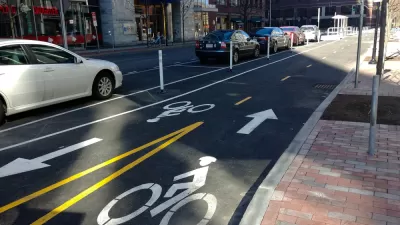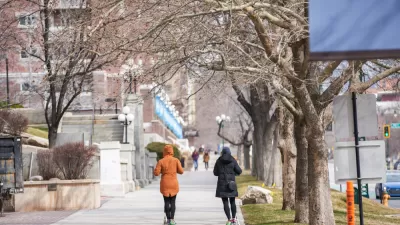An intersection configuration mastered by the Dutch is about to get its first showcase in the capital of Utah as part of a larger bike lane project through the center of the city.
"Salt Lake City is on track to implement America’s first protected intersection for bicycling this summer," reports Angie Schmitt.
"The intersection design is based on a Dutch template that minimizes potential conflicts between people biking, driving, and walking. For example, it allows cyclists to make a left turn in two stages without crossing against oncoming car traffic." Schmitt's article also includes a few renderings and diagrams breaking down the configuration of the Dutch intersection treatment.
The intersection will be included in a bike lane project on 200 West between 900 South and North Temple. Construction will begin in August, according to a separate article by Celeste Tholen Rosenlof. Tholen Rosenlof also notes that 200 West falls short of its vehicle capacity by 90 percent, "making it an ideal location to integrate “low stress” bikeways, according to the city [pdf]."
The design for the protected intersection will be familiar to Planetizen readers thanks to the work of Nick Falbo, a Portland-based planner who made the case for the design last year.
FULL STORY: Salt Lake City to Install Nation’s First Protected Intersection for Bicycling

Americans May Be Stuck — But Why?
Americans are moving a lot less than they once did, and that is a problem. While Yoni Applebaum, in his highly-publicized article Stuck, gets the reasons badly wrong, it's still important to ask: why are we moving so much less than before?

Using Old Oil and Gas Wells for Green Energy Storage
Penn State researchers have found that repurposing abandoned oil and gas wells for geothermal-assisted compressed-air energy storage can boost efficiency, reduce environmental risks, and support clean energy and job transitions.

Placekeeping: Setting a New Precedent for City Planners
How a preservation-based approach to redevelopment and urban design can prevent displacement and honor legacy communities.

San Francisco’s Muni Ridership Grew in 2024
The system saw its highest ridership since before the Covid-19 pandemic, but faces a severe budget shortage in the coming year.

Colorado Lawmakers Move to Protect BRT Funding
In the face of potential federal funding cuts, CDOT leaders reasserted their commitment to planned bus rapid transit projects.

Safe Streets Funding in Jeopardy
The Trump administration is specifically targeting bike infrastructure and other road safety projects in its funding cuts.
Urban Design for Planners 1: Software Tools
This six-course series explores essential urban design concepts using open source software and equips planners with the tools they need to participate fully in the urban design process.
Planning for Universal Design
Learn the tools for implementing Universal Design in planning regulations.
Heyer Gruel & Associates PA
City of Moreno Valley
Institute for Housing and Urban Development Studies (IHS)
City of Grandview
Harvard GSD Executive Education
Salt Lake City
NYU Wagner Graduate School of Public Service
City of Cambridge, Maryland




























